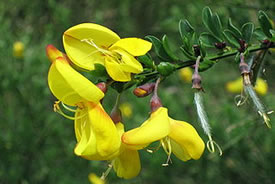
Scotch broom (Photo by Wikimedia Commons)
Scotch broom
Scotch broom is a perennial shrub originally from Europe. Introduced as an ornamental plant in the mid-19th century, it is now the poster child of invasive species in British Columbia.
According to the BC Invasive Species Council, it would seem Scotch broom was also used to pack whiskey cases for gold camps along the west coast. Once the packing material was discarded, this allowed the spread of the plant even further. Scotch broom was also used for many years as a means of preventing soil erosion along roadsides.
How is it identified?
Broom is a dark green deciduous shrub up to three metres tall, with small leaves and yellow or occasionally white flowers, having with a purple or brownish tinge. The flowers appear in early spring and develop into pods by summer. Broom has a deep root and a waxy covering on its branches and small leaves.
How does it grow?
The plant's photosynthetic stems allow it to grow year-round, thereby out-competing other native species, including Douglas-fir and Garry oak. It is also noxious to humans and animals if ingested. Today, it is found throughout much of the southern BC mainland, Vancouver Island and the Gulf Islands.
Once introduced, this invasive species grows in dense patches, further choking out native species. Mature plants can produce upwards of 3,500 seed pods, which each produce 15-20 seeds that can remain viable for up to 30 years.
Where does it grow?
Since being introduced to BC., broom has spread from the Sooke area up the east side of Vancouver Island. It has been reported on the Gulf Islands as far north as Cortes, Hernando, Savary and Texada Islands. Broom can be found on the lower Mainland, on the Sunshine Coast to Powell River, and through the Fraser Valley and Chilliwack Valley to Hope.
What does it threaten?
The plant grows quickly, crowding out wildflower species and reducing open habitat favoured by native birds and butterflies. The roots of the plant hold bacteria that change the soil and has a very high oil content, making it extremely flammable.
What is NCC doing to control this species?
Each year a huge amount of time and energy is put in to trying to control this invasive species. Throughout British Columbia many groups — ranging from parks departments, to conservation groups, nature groups and biologists — have joined to fight this invasive on private, public and Crown lands. Broom bashes are frequently held throughout the plant's range, where volunteers cut, pull and dig out the plants, even in areas that are difficult to access and the weed pile is sometimes air lifted out by helicopter. Once gathered, the piles are burned.
How can you help?
Everyone can help to win the battle against alien invasive species. Here are some ways you can help:
- Dispose of yard waste properly. Dumping yard waste in natural areas can introduce alien invasive species that will thrive and spread. Even leaf piles can be problematic, as dumped piles can smother native vegetation. Contact your municipality to find out how to dispose of yard waste properly.
- Plant native species in your garden. There are lots of beautiful native species that attract native butterflies and birds, making your garden twice as beautiful. Native species are also adapted to our climate and often require less rigorous care than exotic species.
- Clean your shoes or bicycle tires when moving between designated trails in different areas. Invasive plants are often spread accidentally from seeds stuck in treads.
- More information about control of scotch broom is available through the Invasive Species Council of British Columbia or call 250-305-1003.




